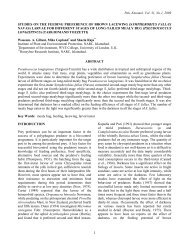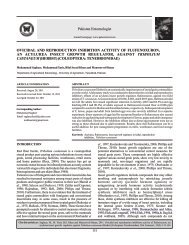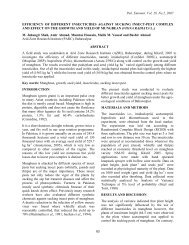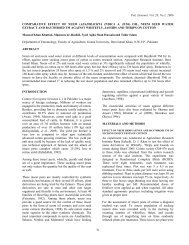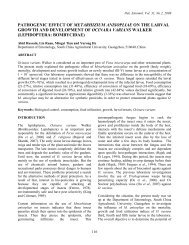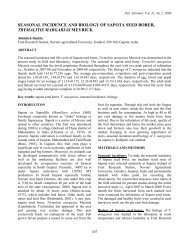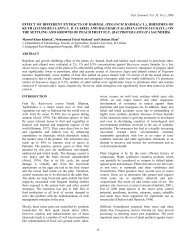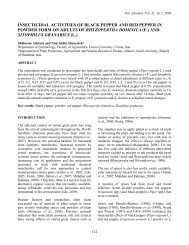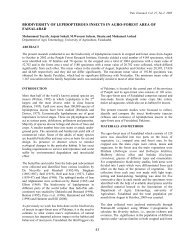biodiversity of insects associated with sugarcane crop in faisalabad
biodiversity of insects associated with sugarcane crop in faisalabad
biodiversity of insects associated with sugarcane crop in faisalabad
Create successful ePaper yourself
Turn your PDF publications into a flip-book with our unique Google optimized e-Paper software.
Pak. Entomol. Vol. 26, No.1, 2004<br />
BIODIVERSITY OF INSECTS ASSOCIATED WITH<br />
SUGARCANE CROP IN FAISALABAD<br />
Adnan Ahmed, Anjum Suhail, Za<strong>in</strong>-ul-Abd<strong>in</strong>, Sohaib Iftikhar and Kashif Zahoor<br />
Department <strong>of</strong> Agri. Entomology, University <strong>of</strong> Agriculture, Faisalabad<br />
ABSTRACT<br />
Studies were carried out <strong>in</strong> three localities (Shahbaz pur, Agriculture University<br />
Faisalabad and Makkuana) on the farmers’ fields. Data were collected on fortnightly basis by<br />
us<strong>in</strong>g hand net, light traps, malaise traps and pit fall traps and were analyzed statistically,<br />
us<strong>in</strong>g Shannon-We<strong>in</strong>er <strong>in</strong>dex <strong>of</strong> diversity. Species richness provides an extremely useful<br />
measurement <strong>of</strong> diversity when a complete catalogue <strong>of</strong> species <strong>in</strong> the community is<br />
obta<strong>in</strong>ed. A total <strong>of</strong> 11720 specimens belong<strong>in</strong>g to different <strong>in</strong>sect orders were captured <strong>in</strong><br />
three localities. About 117 species <strong>associated</strong> <strong>with</strong> <strong>sugarcane</strong> were identified. The diversity.,<br />
maximum diversity, species richness and species evenness <strong>in</strong> three localities were 1.55, 2.0,<br />
0.22 & 0.77 and 1.66, 2.0, 0.17 & 0.83 and 1.75, 2.0, 0.13 & 0.87, respectively.<br />
INTRODUCTION<br />
Species richness provides an extremely useful<br />
measurement <strong>of</strong> diversity where a complete<br />
catalogue <strong>of</strong> species <strong>in</strong> the community is obta<strong>in</strong>ed<br />
(Magurran, 1988).<br />
Biodiversity entails all form <strong>of</strong> biological<br />
entities <strong>in</strong>habit<strong>in</strong>g the Earth-<strong>in</strong>clud<strong>in</strong>g prokaryotes<br />
and eukaryotes, wild plants & animals and<br />
cultivated plants and even genetic material like<br />
seeds and germplasm (Kothari, 1992)<br />
Insects have great potential for understand<strong>in</strong>g<br />
ecosystem as measures <strong>of</strong> ecosystem health, but the<br />
<strong>in</strong>completeness <strong>of</strong> knowledge and the limitation <strong>of</strong><br />
resources <strong>in</strong>crease the difficulty <strong>of</strong> work on <strong>in</strong>sect<br />
<strong>biodiversity</strong>. The formal treatment <strong>of</strong> <strong>biodiversity</strong><br />
and its measures is complex. Despite considerable<br />
<strong>in</strong>terest <strong>in</strong> this subject, the use and application <strong>of</strong><br />
measurement <strong>in</strong>dices is heterogeneous (Williamson,<br />
1995)<br />
About 103 <strong><strong>in</strong>sects</strong> species <strong>associated</strong> <strong>with</strong><br />
<strong>sugarcane</strong> compris<strong>in</strong>g <strong>of</strong> Coleopteran (31 spp),<br />
Dictyoptera (2spp), Diptera (5spp), Hemiptera<br />
(12spp), Homoptera (18spp), Hymenoptera (7spp),<br />
Isoptera (3spp), Lepidoptera (13spp), Orthoptera (9<br />
spp) and one species <strong>of</strong> each <strong>of</strong> Thysanoptera,<br />
Neuroptera and Trichoptera (Kumaras<strong>in</strong>ghe, 1999).<br />
Sugar cane is a highly important cash <strong>crop</strong> and<br />
sugar production <strong>in</strong> the country mostly depends on<br />
this <strong>crop</strong>. It shares <strong>in</strong> value added <strong>in</strong> Agri and GDP<br />
are 6.2% and 1.5% respectively (Annonymous,<br />
2003).<br />
The number <strong>of</strong> eggs, nymphs and adults <strong>of</strong><br />
Pyrilla perpusilla were high <strong>in</strong> July, August and<br />
October (Fernando and Ganehiarachchi, 2000).<br />
Pest activity <strong>of</strong> pest (Root borer) was observed<br />
from January to December, and the population peak<br />
dur<strong>in</strong>g the second fortnight <strong>of</strong> September (Pandya<br />
and Patels, 1998).<br />
The activity <strong>of</strong> the pest (Top borer) was found<br />
spread over the months <strong>of</strong> January to December<br />
<strong>with</strong> a peak population level <strong>in</strong> the second fortnight<br />
<strong>of</strong> May (Pandya and Patels, 1998).<br />
Intensive studies on the population dynamics <strong>of</strong><br />
the scarab pests have sought to understand the cause<br />
<strong>of</strong> outbreaks (Robertson, 1999).<br />
65
Pak. Entomol. Vol. 26, No.1, 2004<br />
Previously no work has been done on the<br />
<strong>biodiversity</strong> <strong>of</strong> <strong><strong>in</strong>sects</strong> <strong>associated</strong> <strong>with</strong> <strong>sugarcane</strong><br />
<strong>crop</strong> <strong>in</strong> Faisalabad. So, it is the need <strong>of</strong> the time to<br />
estimate to what extent man’s exploitation <strong>of</strong> natural<br />
resources has imparted adverse impact on the<br />
<strong>biodiversity</strong> <strong>of</strong> <strong><strong>in</strong>sects</strong>. The present research was<br />
conducted to estimate the <strong>biodiversity</strong> <strong>of</strong> <strong><strong>in</strong>sects</strong><br />
<strong>associated</strong> <strong>with</strong> <strong>sugarcane</strong> <strong>crop</strong> <strong>in</strong> Faisalabad.<br />
MATERIALS AND METHODS<br />
Three localities were selected for the study <strong>of</strong><br />
<strong>biodiversity</strong> <strong>of</strong> <strong><strong>in</strong>sects</strong> <strong>associated</strong> <strong>with</strong> <strong>sugarcane</strong><br />
<strong>crop</strong> <strong>in</strong> Faisalabad. These localities were Shahbaz<br />
pur, Makkuana, University <strong>of</strong> Agriculture.<br />
Collection was done on the farmers fields.<br />
Collection was made randomly by nett<strong>in</strong>g, hand<br />
pick<strong>in</strong>g, pitfall traps, malaise and light traps (one<br />
light trap <strong>in</strong> each locality). Pitfall traps were set<br />
diagonally <strong>in</strong> middle and sides <strong>of</strong> the field after<br />
every 10 foot steps <strong>in</strong> every acre which were<br />
selected randomly. Pitfall traps were “dustb<strong>in</strong>s” <strong>of</strong> 6<br />
<strong>in</strong>ch diameter and 10 <strong>in</strong>ch height, buried <strong>in</strong> the soil.<br />
Each trap was laid <strong>in</strong> such a way that the tips <strong>of</strong> the<br />
trap was flush <strong>with</strong> the surface <strong>of</strong> the ground. A<br />
plastic lid was suspended approximately 4 cm above<br />
the ground level to protect aga<strong>in</strong>st <strong>in</strong>undation dur<strong>in</strong>g<br />
the period <strong>of</strong> heavy ra<strong>in</strong>fall and evaporation <strong>in</strong> direct<br />
sunlight (Kle<strong>in</strong>, 1989). 10 per cent formal<strong>in</strong>e<br />
solution was used <strong>in</strong> these pitfall traps. A total <strong>of</strong> 15<br />
for each census <strong>in</strong> <strong>crop</strong> area were left up to 24 hr.<br />
Sampl<strong>in</strong>g was done for 2 consecutive days <strong>in</strong><br />
each fortnight and total population per month was<br />
counted. The specimens for each and every<br />
collection day were treated separately and were put<br />
<strong>in</strong>to vials for <strong>biodiversity</strong> count.<br />
Identification <strong>of</strong> <strong>in</strong>sect’s species<br />
The collected specimens were stored <strong>in</strong> vials<br />
conta<strong>in</strong><strong>in</strong>g formal<strong>in</strong>e solution and identified to<br />
species level. The identification <strong>of</strong> specimens was<br />
done <strong>in</strong> “Insect Biodiversity and Biosystematics<br />
Research Lab.” Department <strong>of</strong> Agri.Entomology,<br />
University <strong>of</strong> Agriculture, Faisalabad (Pakistan),<br />
<strong>with</strong> the help <strong>of</strong> related taxonomic material. Some<br />
<strong>of</strong> the specimens were identified by compar<strong>in</strong>g<br />
specimens aga<strong>in</strong>st collection <strong>in</strong> Museum <strong>of</strong> CABI<br />
Regional Biosciences Centre, Daata Gunj Bukhsh<br />
Road, Rawalp<strong>in</strong>di.<br />
Diversity Index<br />
The <strong>biodiversity</strong> count was made to estimate<br />
species richness, species evenness and species<br />
diversity (Kikkawa, 1996) by us<strong>in</strong>g Shannon<br />
diversity <strong>in</strong>dex (Shannon, 1948) as follows.<br />
H =<br />
OR<br />
∑<br />
nlogn −<br />
H′<br />
=<br />
n<br />
H′<br />
max = logk<br />
H′<br />
J′<br />
=<br />
H′<br />
max<br />
D = 1−<br />
J′<br />
(pi − In(pi))<br />
k<br />
∑<br />
i<br />
filog fi<br />
H is the diversity; pi is the population <strong>of</strong> ith<br />
species <strong>in</strong> <strong>crop</strong> area. H’ is the diversity <strong>in</strong>dex <strong>of</strong><br />
total number <strong>of</strong> collected specimens, fi is the<br />
proportion <strong>of</strong> ith species, H’max is the maximum<br />
diversity, K is the total number <strong>of</strong> species <strong>in</strong> the<br />
entire <strong>crop</strong> area j’ is the evenness and D represents<br />
dom<strong>in</strong>ance <strong>of</strong> species<br />
RESULTS AND DISCUSSION<br />
The research studies were conducted dur<strong>in</strong>g<br />
March to August <strong>in</strong> 2004. A total <strong>of</strong> 11720<br />
specimens belong<strong>in</strong>g to different <strong><strong>in</strong>sects</strong> orders were<br />
captured represent<strong>in</strong>g 117 species. Diversity,<br />
species richness, species evenness were calculated<br />
by Shannon-We<strong>in</strong>er diversity <strong>in</strong>dex. The evenness<br />
value showed that the whole <strong>of</strong> the <strong>crop</strong> area was<br />
evenly distributed <strong>with</strong> only the dom<strong>in</strong>ance <strong>of</strong> few<br />
species <strong>of</strong> different orders namely Homoptera <strong>with</strong><br />
highest population <strong>of</strong> <strong>sugarcane</strong> plant hopper<br />
(Pyrilla perpusilla, Ot<strong>in</strong>otus oneratus, Perk<strong>in</strong>csiella<br />
sp, Alerolobus barodenesis). Lepidoptera<br />
(Svripophaga nivella, Chilo <strong>in</strong>fuscatellus,<br />
Emmalocera depressella, Acherontia atropos).<br />
Orthoptera (Atractomorpha acutipennis,<br />
Coenagrion puella, Gryllus bimaculatus,<br />
Trigonidium cic<strong>in</strong>deloides, Chrotogonus<br />
trachypterous, Oxya <strong>in</strong>tricata, Euconocephalus<br />
<strong>in</strong>certus, Hedotettix gracilis, Chlaenius quadricolor,<br />
66
Pak. Entomol. Vol. 26, No.1, 2004<br />
Orthrophagus atroplitus, Coleoptera (Calosoma<br />
maderae, Craspendophorus elegans, Orthrophagus<br />
atroplitus, Scrabaeus brahm<strong>in</strong>us, Heteroderes lenis,<br />
Aspidomorpha miliaris, Aulocophora foveicolis),<br />
Hymenoptera (Vespa orientalus, Rhyssa<br />
persuasoria, Formica Spp., Monomorium<br />
m<strong>in</strong>imum.<br />
Table 1: Result <strong>of</strong> Shannon-We<strong>in</strong>er<br />
diversity <strong>in</strong>dex.<br />
Biodiversity<br />
Components<br />
Shahbaz<br />
pur<br />
Makkuana Agriculture<br />
University<br />
Diversity (H) 1.55 1.66 1.75<br />
Max. Diversity 2.0 2.0 2.0<br />
Evenness (J’) 0.22 0.17 0.13<br />
Richness 0.77 0.83 0.87<br />
The value <strong>of</strong> Diversity (1.66) was maximum <strong>in</strong><br />
Makkuana and m<strong>in</strong>imum (1.55) <strong>in</strong> Shahbaz pur.<br />
Maximum Diversity (2.0) was same <strong>in</strong> all three<br />
localities. Evenness was maximum (0.22) <strong>in</strong><br />
Shahbaz pur and m<strong>in</strong>imum (0.13) <strong>in</strong> Agriculture<br />
University. Richness was maximum (0.87) <strong>in</strong><br />
Agriculture University and m<strong>in</strong>imum (0.77) <strong>in</strong><br />
Shahbaz pur.<br />
The temperature was recorded maximum (42.5<br />
o C) <strong>in</strong> the month <strong>of</strong> July and m<strong>in</strong>imum (38.4 o C) <strong>in</strong><br />
the month <strong>of</strong> March. Relative humidity was<br />
recorded maximum (66 %) <strong>in</strong> August and m<strong>in</strong>imum<br />
(27%) <strong>in</strong> May. Maximum ra<strong>in</strong> fall (130 mm) was<br />
recorded <strong>in</strong> the month <strong>of</strong> July and m<strong>in</strong>imum (4.6<br />
mm) <strong>in</strong> the month <strong>of</strong> June.<br />
Homoptera (2170), Hemiptera (939),<br />
Lepidoptera (2140), Coleoptera (1254), Isoptera<br />
(1248) and Orthoptera(1053) were <strong>in</strong> abundance <strong>in</strong><br />
<strong>sugarcane</strong> fields dur<strong>in</strong>g the collection periods<br />
followed by Neuropteran (318), Diptera (1132),<br />
Odonata (324) and Hymenoptera (884). The<br />
maximum <strong>in</strong>sect population was observed <strong>in</strong> the<br />
months <strong>of</strong> July and August because there was<br />
maximum relative humidity (64% & 66%<br />
respectively) and ra<strong>in</strong>fall (130 mm and 60.7 mm,<br />
respectively) <strong>in</strong> July and August.<br />
Table 2:<br />
Months<br />
Meterological data for six months.<br />
Temperature<br />
(C o ) Avg.<br />
Max.<br />
M<strong>in</strong>.<br />
Relative<br />
Humidity<br />
(%) Avg.<br />
Ra<strong>in</strong>fall<br />
(mm)<br />
March 38.4 24.7 31 19.0<br />
April 38.6 24.9 30 16.0<br />
May 40.2 26.4 27 16.4<br />
June 42.5 29.7 44 4.6<br />
July 39.8 28.6 64 130<br />
August 39.4 28.1 66 60.7<br />
The population <strong>of</strong> <strong>sugarcane</strong> leaf hopper<br />
<strong>in</strong>creased from March to April and the curve was<br />
dim<strong>in</strong>ish<strong>in</strong>g uptill June show<strong>in</strong>g that there was a<br />
marked decrease <strong>in</strong> population <strong>in</strong> the month <strong>of</strong> June<br />
at high temperature (42.5 o C) and low relative<br />
humidity (44%). Similarly the population <strong>of</strong><br />
<strong>sugarcane</strong> stem borer, <strong>sugarcane</strong> top borer,<br />
<strong>sugarcane</strong> root borer and <strong>sugarcane</strong> black bug<br />
<strong>in</strong>creased from March to April and there was a<br />
marked decrease <strong>in</strong> population <strong>of</strong> these pests <strong>in</strong> the<br />
month <strong>of</strong> June at high temperature (42.5 o C) and less<br />
relative humidity (44%). But the population <strong>of</strong><br />
<strong>sugarcane</strong> whitefly did not show a marked <strong>in</strong>crease<br />
<strong>in</strong> the months <strong>of</strong> July and August due to high<br />
relative humidity (66%). The population <strong>of</strong> whitefly<br />
showed a little <strong>in</strong>crease <strong>in</strong> the month <strong>of</strong> May<br />
because <strong>of</strong> low relative humidity (27%).<br />
The ETL <strong>of</strong> Pyrilla perpusilla is 2 adults or<br />
nymphs per leaf and the observed (5 per leaf)<br />
population which was much higher than the<br />
predeterm<strong>in</strong>ed ETL. So, Pyrilla perpusilla is the<br />
potential pest dur<strong>in</strong>g collection period and<br />
67
Pak. Entomol. Vol. 26, No.1, 2004<br />
maximum population dur<strong>in</strong>g July-August. The<br />
predeterm<strong>in</strong>ed ETL <strong>of</strong> borers is 10% attacked<br />
plants, the observed damaged plants were also 10%<br />
dur<strong>in</strong>g the collection period (April & May and July<br />
& August), maximum damage was dur<strong>in</strong>g the<br />
months <strong>of</strong> July & August.<br />
2500<br />
2000<br />
1500<br />
1000<br />
500<br />
0<br />
Collembola<br />
Odonata<br />
Orthoptera<br />
Dermapter<br />
a<br />
Neutoptera<br />
Isoptera<br />
Hemiptera<br />
Homoptera<br />
Coleoptera<br />
Lepidopter<br />
a<br />
Hymenopte<br />
ra<br />
Diptera<br />
CONCLUSION<br />
• March & April and July & August are the four<br />
critical months for the <strong>sugarcane</strong> <strong>crop</strong>.<br />
• All three types <strong>of</strong> borers (top borer, stem borer,<br />
root borer) are potential pests as their ETL are<br />
<strong>in</strong> accordance <strong>with</strong> the predeterm<strong>in</strong>ed ETL.<br />
Also the ETL <strong>of</strong> <strong>sugarcane</strong> plant hopper (Pyrilla<br />
perpusilla) was higher than the predeterm<strong>in</strong>ed<br />
ETL. So Pyrilla is also a potential pest <strong>of</strong><br />
<strong>sugarcane</strong> <strong>crop</strong>.<br />
• Control strategies should be applied on the 1 st<br />
fortnight <strong>of</strong> March and last fortnight <strong>of</strong> April.<br />
Series1<br />
Insect Numbers<br />
Fig 1: Insect fauna <strong>of</strong> <strong>sugarcane</strong> <strong>in</strong><br />
Faisalabad<br />
6000<br />
5000<br />
4000<br />
3000<br />
2000<br />
1000<br />
0<br />
March<br />
April<br />
May<br />
June<br />
Months<br />
July<br />
August<br />
Series1<br />
Fig. 2: Insect population <strong>in</strong> different Months<br />
Population size<br />
1400<br />
1200<br />
1000<br />
800<br />
600<br />
400<br />
200<br />
0<br />
Pest population <strong>in</strong> different Months<br />
March<br />
April<br />
May<br />
June<br />
July<br />
August<br />
Months<br />
top borer<br />
stem borer<br />
root borer<br />
leaf hopper<br />
Fig.3: Pest population <strong>in</strong> different Months<br />
REFERENCES<br />
Andersen,A.N., J.A. Ludwig, L.M. Lowe and<br />
D.C.F. Rentz, 2001. Grasshoppers <strong>biodiversity</strong><br />
and bio<strong>in</strong>dicators <strong>in</strong> Australian tropical<br />
savannas. Austral. Ecol., 26(3): 213-222.<br />
Annonymus, 2003. Economic survey <strong>of</strong> Pakistan,<br />
2002-03.<br />
Gasm. G. and I.V.S. Fernando, 2000. Population<br />
dynamics <strong>of</strong> the <strong>sugarcane</strong> plant hopper (Pyrilla<br />
perpusilla) <strong>in</strong> the wet zone <strong>of</strong> Sri Lanka.<br />
Tropical. Sci., 40: 3, 144-153: 7 ref.<br />
Kothari, A., 1992. The Biodiversity Convension: an<br />
Indian viewpo<strong>in</strong>t. Santuary, 12 (3): 34-43.<br />
Kumaras<strong>in</strong>ghe, N.C., 1999. Insect fauna <strong>associated</strong><br />
<strong>with</strong> <strong>sugarcane</strong> plantations <strong>in</strong> Sri Lanka<br />
Division <strong>of</strong> Pest Management, Sugarcane<br />
Research Institute, Uda Walawe 70190, Sri<br />
Lanka.<br />
Kikkawa, J., 1996. Complexity, Diversity and<br />
Stability. In Community ecology: pattern and<br />
process. Blackwell Scientific Publication,<br />
Melbouren. Pp. 41-65.<br />
Kle<strong>in</strong>, B. C., 1989.Effect <strong>of</strong> forest fragmentation on<br />
dung and carrion beetle communities <strong>in</strong> central<br />
Amazonia. Ecol., 70 (6): 1715-1725.<br />
68
Pak. Entomol. Vol. 26, No.1, 2004<br />
Magurran, A. E., 1988. Ecological Diversity<br />
and Management. Pr<strong>in</strong>ceton University<br />
Press, Pr<strong>in</strong>ceton, NJ. In: Insect Ecology:<br />
An Ecosystem Approach. Academic<br />
Press. USA. pp.221-247.<br />
Robertson et al. 1999. Comparative review<br />
<strong>of</strong> population dynamics <strong>of</strong> scrab pests.<br />
Sugar Research and Development<br />
Corporation, P.O. Box 2151, Innisfail,<br />
old, 4860, Australia.<br />
Shannon, C.E. 1948. A mathematical theory<br />
<strong>of</strong> communication. Bell System tech. J.,<br />
27 : 37-423, 623-656.<br />
Williamson, M. 1995. Species diversity <strong>in</strong><br />
ecological communities. Pp. 325-336.<br />
In: Barlett, M. S. and R. W. Horns<br />
(eds.). The Mathematical theory <strong>of</strong> the<br />
dynamics <strong>of</strong> biological populations.<br />
Academic Press. London.<br />
Wilson, E.O., 1992. The diversity <strong>of</strong> life.<br />
Norton. New York, U.S.A.<br />
69



